| Membership | Price (+HST) |
|---|---|
| Single | $85/year |
| Single Plus | $120/year |
| Family | $130/year |
| Family Plus | $175/year |
| Contributing | $300/year |
| Supporting | $600/year |
| Sustaining | $1,000/year |
| Benefactor's Circle | $2,500/year |
| Director's Circle | $5,000/year |
| President's Circle | $10,000/year |
Why Xeriscape? What You Need to Know About This Hot Garden Trend of 2023
By Andrea Berwick CLD, Landscape Designer, Royal Botanical Gardens
It probably doesn’t come to much of a surprise that as we look at gardening trends over recent years, many underlying themes continue to be relevant into 2023 such as low maintenance, lower water use, and pollinator/wildlife considerations. These are all elements that can be captured through xeriscaping.
What is Xeriscaping?
In Southern Ontario we seem to be experiencing more and more extreme temperatures 365 days of the year. We are experiencing hotter, dryer summers and an overall significant increase in precipitation; rain and snow (Canada, 2019). These events can cause stress on our drainage systems, especially during those flash floods and increases the use of resources such as water, electricity and ultimately money out of our wallets.
The premise of xeriscaping is creating design solutions that support water-wise gardening. This is done through stormwater management of our hardscapes and softscapes.
Hardscape Solutions
For hard surfaces such as patios or driveways, it’s about managing runoff so that water can infiltrate and slowly drain away instead of ‘running off’ and overwhelming our catch basins. This can be achieved through using products such as permeable paving, gravel, or turf stones.
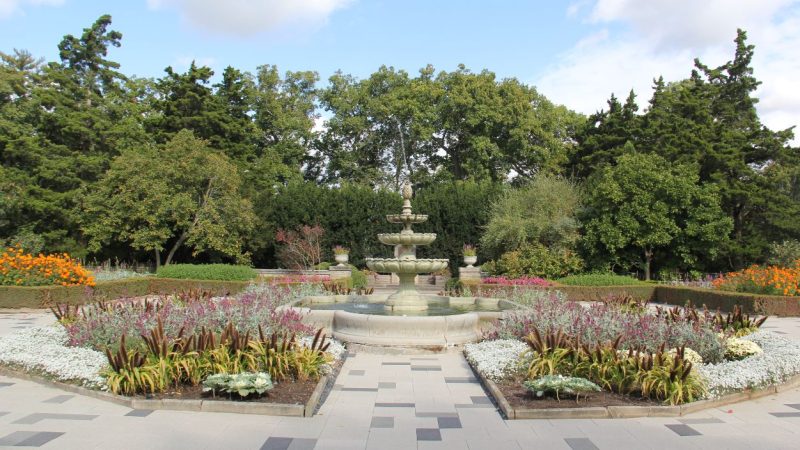
Permeable paving in the Scented Garden Courtyard, Hendrie Park.
Collecting Water
We can ease our water bills by collecting and utilizing rainwater whether by using rain barrels or an underground cistern. These are typically built into rain gardens with sites graded so that the rain will pool and drain into the cistern.
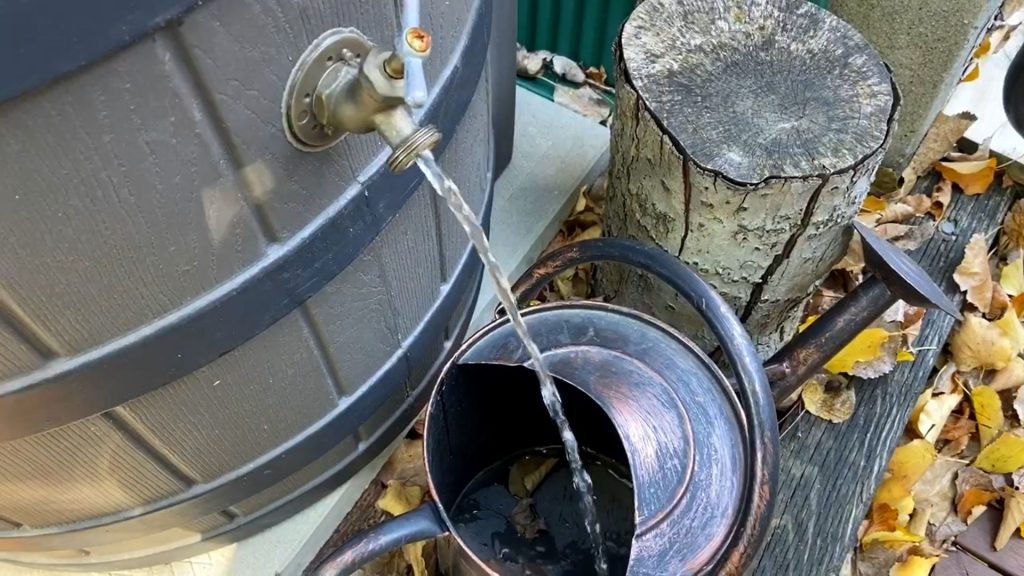
Plant Selection
Successful plant growth always begins with working with the existing site conditions provided and not against them. This includes for example, light exposure, soil type, grading, drainage etc. Choosing the right plants for the environment is key instead of purchasing plants and altering the site to fit its needs.
Plant themes that fit xeriscaping criteria typically fall into the drought tolerant category. These include Mediterranean or alpine. Native plants also offer tougher resilience to environmental stresses over some non-natives.
Left to right: Coneflower, Giant blue hyssop, Torch lily, Yucca
Wildlife Considerations
Plants can reconnect us with nature and also serve as hosts to many forms of life such as insects and animals by offering food and or refuge. Choosing the right plants can improve the biodiversity of life and make a difference right in your own backyard. For example, as Doug Tallamy, entomologist and University of Delaware Professor says, “Oaks support more life-forms than any other North American tree genus, providing food, protection or both for birds to bears, as well as countless insects and spiders, among the enormous diversity of species.” (Roach, 2021) He has also researched that oak trees support 897 caterpillar species in the United States and of the food eaten by insects, birds and other animals, 75 percent comes from a few key genera; which oaks are at the top of (Roach, 2021).
Left to right: Stonecrop, Northern Red Oak, Wild bergamot
Lawn Care
When it comes to lawns, many of us see the value in having one whether for recreational purposes or simply as a low maintenance landscape feature. But the question is, how can we have one if we want to adopt the xeriscaping approach?
Here at RBG, our horticulture department has been looking for ways to cut back on our water use. Our biggest water guzzler by far has been our lawns and trying to keep them green on those sunny hot July days. It seems that we are faced with heavy water use or having them go brown and crispy with no middle ground.
Upon closer consideration of the types of grass species we are growing in our lawns, the dominant one has always been Kentucky Blue Grass. This grows great in cooler climates where it stays green all summer but will go dormant in the heat. Our Head of Horticulture, Jim Mack has been changing the way RBG approaches turf maintenance. Since 2015, the use of bluegrass sod has all but disappeared on projects in favour of using more water sustainable options.
“The right seed selection is key when the absolute need to have turfgrass is called for”, Jim says. “Hydroseeding has become the go-to preferred method for establishing turfgrass cover in areas that need it. Working with a reputable contractor has allowed us to customize our seed mixtures to suite our use and has allowed the use of newer blends of turf-type (TT) tall fescues and turf-type (TT) perennial ryegrass cultivars to be used in place of bluegrass varieties which were formerly the turfgrass of choice. Some of the TT fescues and ryegrasses now have an improved ability to tiller and spread than earlier cultivars, which helps with turf density and competition with weeds. They also require substantially less irrigation (when established), are more resistant to insect damage, and require no additional fertilization than the estimated 1% of Nitrogen they receive from leaving the lawn clippings on our turf as a maintenance best practice. RBG also observes the practice of mowing our lawns at a height of 4” through the heat of the summer. Keeping turf longer actually saves water and helps suppress weeds looking for daylight”.
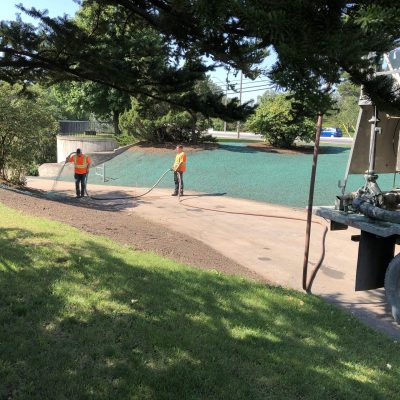
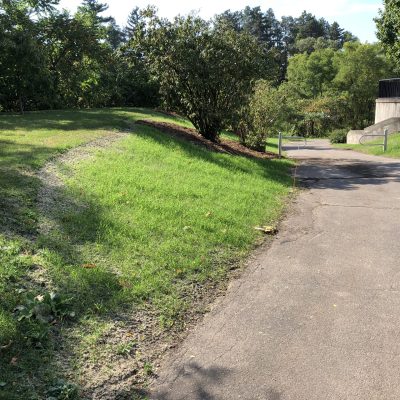
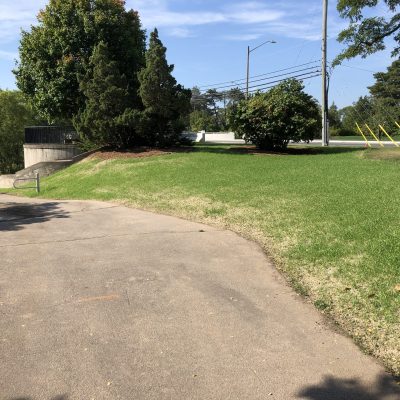
Hydroseeding at Rock Garden Tunnel.
References
Canada, G. o. (2019, April 09). Changes in Precipitation. Retrieved from Government of Canada: https://www.canada.ca/en/environment-climate-change/services/climate-change/canadian-centre-climate-services/basics/trends-projections/changes-precipitation.html
Roach, M. (2021, March 31). Why You Should Plant Oaks. Retrieved from The New York Times: https://www.nytimes.com/2021/03/31/realestate/oak-trees-why-you-should-plant.html
Andrea is a certified landscape designer and has won several landscape awards of excellence from Landscape Ontario.
Blooms by Season
Plants of interest are ever-changing in RBG’s five cultivated garden areas and nature sanctuaries. Learn what’s blooming now or see the blooms calendar for a rough estimation of what to expect each season.




















